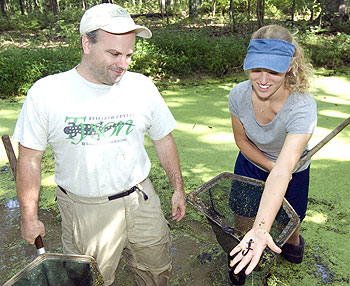Jonathan M. Chase, Ph.D., associate professor of biology in Arts & Sciences, has been named director of the Tyson Research Center by Edward S. Macias, executive vice chancellor, dean of Arts & Sciences and the Barbara and David Thomas Distinguished Professor in Arts & Sciences.

“A major thrust of Washington University now and in the future is energy, environment and sustainability,” Macias said. “Jon Chase, an ecologist whose research on the environment and ecology is very widely respected, has a vision to make the Tyson Research Center a sterling example of how a university research station can enable a better understanding of these issues.
“We’re very pleased to have Jon at the helm of Tyson, which will become a cornerstone of this initiative,” Macias said.
Chase’s appointment became effective Sept. 1. He has served as interim director since 2005. He is only the third permanent director to oversee research and activities at the 2,000-acre field site since 1970.
“Our department made a commitment to build our faculty in ecology about five years ago, and Jon was our first hire,” said Ralph S. Quatrano, Ph.D., the Spencer T. Olin Professor and chair of the Department of Biology in Arts & Sciences. “Since then, he has been a major force in building our faculty. His vision, commitment, expertise and connections with the ecological community will make Tyson an integral part of the campus-wide environmental initiative. Jon will be an outstanding leader.”
Tyson Research Center, just 25 minutes from the Danforth Campus on I-44 at Beaumont and Antire Road, was conveyed to the University in 1963 by the U.S. government following a variety of uses, including munitions storage during World War II and the Korean conflict. The site has more than 80 buildings and installations erected by the government. Before 1941, the land primarily was used for crops and grazing as well as woodlands.
Chase, who studies how current habitat degradation and restoration activities influence patterns of biodiversity, said one of the first things in the works is a new, green building, and he is extending a wide welcome to University and regional researchers to find uses for Tyson.
“We have capital for a new building, which will feature a field lab for environmental research, as well as teaching space,” Chase said. “My hunch is it will be near the current administration building. It will be a green building, and we’re consulting with University architects for design and implementation ideas. It will be a low-impact facility that in itself can serve as an educational and research opportunity.”
In addition, Chase and his WUSTL colleagues are planning to implement a large-scale ecological experiment at the site that will address fundamental questions in environmental biology and provide collaborative research opportunities for undergraduates, graduate students and faculty from WUSTL and elsewhere.
Chase said Tyson is a thriving place and has just endured a very busy summer of research and teaching.
He said there are about 10 WUSTL faculty doing research or teaching at Tyson; six postdoctoral researchers and 15 graduate students are using Tyson, and each summer 10-15 undergraduate researchers use Tyson as a resource. In addition, another 20 or so researchers from other institutions are using it for research activities.
He is looking forward to important papers from researchers using Tyson coming out in scientific journals each year. Researchers are conducting studies on topics ranging from ponds and amphibians to invasive plants, infectious diseases, geology, water chemistry, astronomy, hydrology and archeology. Students and faculty in the School of Art in Arts & Sciences also have made consistent and creative use of Tyson.
Chase is teaching a course in Biology/Environmental Studies that meets entirely at Tyson, including a recent overnight outing for nighttime observations — complete with a campfire and s’mores. He said other faculty, including those from biology, earth and planetary sciences, anthropology, physics, art and environmental studies, are planning to use Tyson for teaching activities in the coming school year.
“We’re open for business,” Chase said. “Tyson is a great facility and a beautiful place, but it’s only 2,000 acres. We have great habitats, but not all of the biological, geological or archaeological sites that would make us complete.”
Chase is trying to build a sizeable network within a 100-mile radius of Tyson of neighboring natural places such as Lone Elk and Castlewood parks, state and county sites, and the Missouri Botanical Garden’s nearby Shaw Nature Preserve to allow WUSTL research activities at those place.
Farther down the road, visitors might see small, rustic cabins on the site.
“Many other field stations have a broader community feel,” he said. “People live there year-round or at least during the field season in cabins on the site. In the past, you’d go out to Tyson, grab some samples and go back to campus. That’s fine, but it’s not conducive to fostering an intellectual atmosphere. Allowing researchers to stay out at Tyson for extended periods would do that.”
Chase is offering the WUSTL community an open house Oct. 19. People can take tours, ask questions, see the sites, then finish with a barbecue.
“We’re reaching out to everybody to see what’s available and possible at Tyson,” Chase said. “It’s open to all schools for many purposes. We hope to have a great turnout.”
For those interested in using Tyson for teaching or research activities, contact Chase at jchase@wustl.edu or 935-4105.